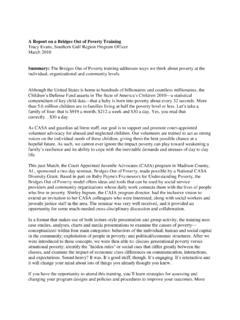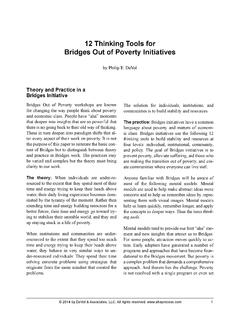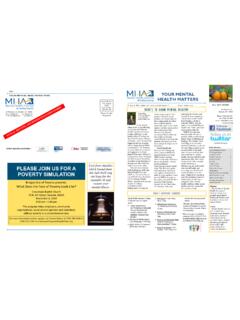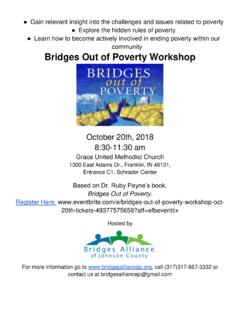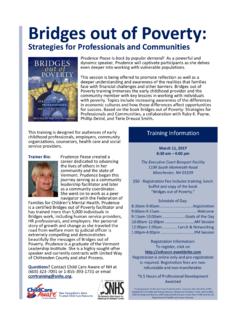Transcription of Bridges out of Poverty / Getting Ahead - NYSCAA
1 Bridges out of Poverty / Getting Ahead and Building Momentum June 1, 2017 NYSCAA Professional Development Conference Growing Body of Work Latest in Getting Ahead Series Viewing Economic Class Issues Through the Triple Lens . Copyright J. Pfarr Consulting 4. The Bridges Model Is NOT a Program People and organizations use Bridges to develop programs and strategies that: Improve relationships at the individual level Improve outcomes at the organizational level Change systems at the community level Bridges helps: Prevent Poverty Alleviate suffering Support people in transition Eliminate Poverty Core Components of Bridges Mental Models Research Continuum (Causes of Poverty ). Hidden Rules of Economic Class Registers of Language Resources Mental Models Are internal pictures of how the world works Exist below awareness Are theories-in-use, often unexamined Determine how we act Can help or interfere with learning For a dialogue to occur, we must suspend our mental models.
2 Source: The Fifth Discipline Fieldbook (1994) by Peter Senge. Build a Mental Model Think of an adult living in generational Poverty . Imagine that you follow that individual for a period of time, observing what happens and how he/she spends his/her time. Write observations in the circle so that the circle represents an average day in the life of this person. Consider activities, not characteristics. Mental Model of Poverty RELATIONSHIPS. Businesses Pawn shop Fast food Liquor store Check cashing Corner store Temp services Rent-to-own Used car lots Laundromat Dollar store Developed by Phil DeVol (2006). Mental Model of Middle Class Businesses Shopping/strip malls Office complexes Bookstores Coffee shops Banks Restaurants/bars Fitness centers Golf courses Developed by Phil DeVol (2006). Veterinary clinics Mental Model of Wealth Developed by Ruby Payne (2005). Analyze the Three Mental Models Review the programs your institution provides. Which mindset are they based on?
3 Poverty , middle class, or wealth? How does class affect your employees, board members, and participants? How does your institution intentionally try to acknowledge the different class experiences and ensure all have voice and power within the institution? Collaboration The intentional creation of a continuum or wraparound services between agencies Sharing information (with customers'. approval), staff, and facilities Theory of Change A map or plan that will arrive at a named result. Institutions have a theory of change for where they, as an institution, want to go. (This may be within the strategic plan of the institution.). Institutions often have theories of change for participants. Perceived Truth vs. Being Effective Though it may be true that the theory of change is needed, that alone will not make an institution or staff effective. When a customer argues for the change to take place, the chance to be effective has dramatically increased.
4 Begin by Listening Research tells us that people are more likely to change when we reverse the flow of communication that is, when people are not talked at but when they themselves have a chance to talk. Richard Farson Research Continuum Behaviors of the Individual Absence of Human and Social Capital Within the Community Human Exploitation Political/Economic Structures Research Continuum Conclusions There is valid research in all four areas. There are many causes of Poverty , so we need a wide array of strategies. An institution wanting to address Poverty will need to address the entire continuum. Community Sustainability Community Grid Sustainability Grid A Comprehensive Planning Tool for A Comprehensive Bridges Steering Planning Committees Tool for Bridges Steering Committees Name the Barrier: Human and Social Political/. Individual Work one barrier Capital in the Exploitation Economic Behavior at a time. Community Structures Individual Action Organizational Action Community Action Policy Source: Facilitator Notes for Getting Ahead in a Just- Getting '-By World Revised Edition by Philip E.
5 DeVol (2013). Hidden Rules Unspoken cues & habits of a group Become part of your belief system and guide how you behave Easily broken because they are hidden . Seldom articulated; equated with intelligence or lack thereof Hidden rules can help people navigate different and difficult situations. Using them skillfully can help build resources. HIDDEN RULES FOR ECONOMIC CLASS. Poverty MIDDLE CLASS WEALTH. POSSESSIONS People. Things. One-of-a-kind objects, legacies, pedigrees. MONEY To be used, spent. To be managed. To be conserved, invested. PERSONALITY Is for entertainment. Is for acquisition and Is for connections. Sense of humor is highly stability. Financial, political, social valued. Achievement is highly connections are highly valued. valued. SOCIAL Social inclusion of the Emphasis is on self- Emphasis is on social EMPHASIS people they like. governance and self- exclusion. sufficiency. FOOD Key question: Did you Key question: Did you like Key question: Was it have enough?
6 It? presented well? Quantity important. Quality important. Presentation important. CLOTHING Clothing valued for Clothing valued for its Clothing valued for its individual style and quality and acceptance into artistic sense and expression of personality. the norms of middle class. expression. Label important. Designer important. TIME Present most important. Future most important. Traditions and past Decisions made for Decisions made against history most important. moment based on feelings future ramifications. Decisions made partially or survival. on basis of tradition decorum. 21. REGISTERS OF LANGUAGE. REGISTER EXPLANATION. Language that is always the same. For example: Lord's FROZEN. Prayer, wedding vows, etc. The standard sentence syntax and word choice of work FORMAL and school. Has complete sentences and specific word choices. Formal register when used in conversation. Discourse CONSULTATIVE. pattern not quite as direct as formal register.
7 Language between friends characterized by a 400- to 800-word vocabulary. Word choice general and not CASUAL. specific. Conversation dependent upon nonverbal assists. Sentence syntax often incomplete. Language between lovers or twins. Language of sexual INTIMATE. harassment. Adapted from the work of Martin Joos STORY STRUCTURE. PATTERNS OF DISCOURSE. FORMAL CASUAL. Definition of Resources To better understand people from Poverty , the definition of Poverty will be the extent to which an individual does without resources.. The resources are the following . Definition of Resources FINANCIAL. Being able to purchase the goods and services of that class and sustain it. EMOTIONAL. Being able to choose and control emotional responses, particularly to negative situations, without engaging in self-destructive behavior. Shows itself through choices. MENTAL. Having the mental abilities and acquired skills (reading, writing, computing) to deal with daily life.
8 SPIRITUAL. Believing in (divine) purpose and guidance. PHYSICAL. Having physical health and mobility. SUPPORT SYSTEMS. Having friends, family, and backup resources available to access in times of need. These are external resources. RELATIONSHIPS/ROLE MODELS. Having frequent access to adult(s) who are appropriate, nurturing, and who do not engage in destructive behavior. KNOWLEDGE OF HIDDEN RULES. Knowing the unspoken cues and habits of a group. Additional Resources Identified by Getting Ahead investigators Integrity and trust: Your word is good, you do what you say you will do, and you are safe. Motivation and persistence: You have the energy and drive to prepare for, plan, and complete projects, jobs, and personal changes. Formal register: You have the emotional control, vocabulary, language ability, and negotiation skills to succeed in school and/or work settings. Getting Ahead in a Just Gettin'-By World Facilitator Notes, Appendix 1 Pages 127 128.
9 Getting Ahead is a way: To examine the impact Poverty has on individuals and the community. To help people stabilize their situation. To provide accurate information to community planners. To help solve community problems. Getting Ahead in a Just Gettin'-By World What happens in Getting Ahead ? A group of 10 - 12 meet for a kitchen-table learning experience Use the triangle as a learning structure 16 sessions/once a week Each session takes about three hours Investigators are paid for their work ACTION. Plans Action steps RESPONSIBILITY. Future stories Critical analysis POWER What it means to me Theory of change How to build resources Economic class UNDERSTANDING. UNDERSTANDING FRAMEWORK WHERE I AM. Poverty . Using the hidden rules What it's like of class to build Monitoring resources now our changes Causes of Poverty Self-assessment Community assessment CO-INVESTIGATION. Module 1. Getting Ahead in a Just Gettin'-By World Expectations of a Getting Ahead Investigator: Attend all sessions.
10 Make up any missed work. Create and live by group rules. Be accountable to the group for being on time and completing work he/she agreed to do. Purpose of Getting Ahead : What Do Participants Get? To explore and analyze the themes of our lives. To assess our resources. To make our own arguments for change. To build our own future stories. To make our own choices. To enjoy the power that comes from solving problems and controlling our own lives. To make concrete plans for economic stability. To become skillful at using the hidden rules of class to build resources. To prepare ourselves to take a seat at the decision making table in our community. How to Support Getting Ahead : Suspend our existing mental models. Make Bridges training available to staff. Sponsor a workshop series. Raise awareness of Bridges / Getting Ahead . Assist with job coaching or mentoring. Pair graduates with job opportunities. Invite graduates to a seat at the table serve on boards, community groups, etc.
